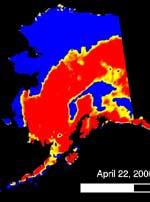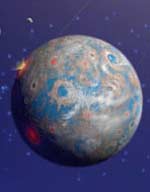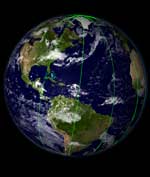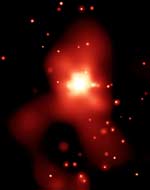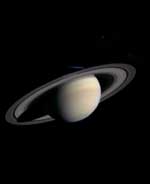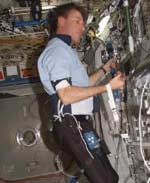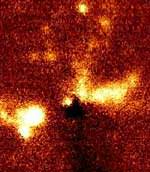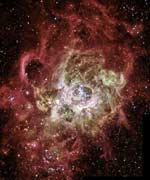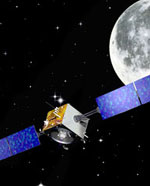
Image credit: ESA
The European Space Agency’s SMART-1 spacecraft is continuing to function well on its long roundabout mission to the Moon. The spacecraft recently completed its 139th orbit and everything seems to be functioning properly, despite the recent solar storms that damaged a few other satellites. It’s running its solar-powered ion drive full time now, and incrementally raising its distance with each orbit around the Earth. SMART-1 will reach its final orbit around the Moon in March 2005.
The spacecraft is now in its 139th orbit, in good operational status and with all functions performing nominally. As previously, the spacecraft was operated in electric propulsion mode almost continuously.
This week we had no flame-outs, probably due to the adopted strategy not to thrust when the orbital altitude is less than 10 000 km. The procedure to automatically re-start the engine after a flame-out will be uploaded to the on-board software this week. Once this is in place, the thrust phase will no longer be interrupted.
The total cumulated thrust time is now more than 946 hours and SMART-1 has consumed almost 15 kg of Xenon. Even with such a low fuel consumption the electric propulsion engine has so far provided a velocity increment of about 665 ms-1 (equivalent to about 2400 km per hour). The electric propulsion engine’s performance, periodically monitored from telemetry data and by ground stations tracking, continues to show a small over performance in thrust, varying from 1.1% to 1.5% over the last week.
The newly adopted strategy to thrust in a direction perpendicular to the position vector in the orbital plane has produced a large perigee increase in the last week of more than 1200 kilometres (see orbital elements and orbit picture).
The degradation of the electrical power produced by the solar arrays is now slowing down considerably. As a matter of fact the available power has remained more or less constant in the last 15 days. This means that the degradation by radiation has matched the increase of solar irradiance due to the nearing of the Earth’s perihelion, so that the net effect is zero. This is explained by the fact that no direct proton radiation from solar activity was experienced and the fact that the spacecraft now stays outside of the radiation belts for a considerable part of its orbit.
The communication, data handling and on-board software subsystems have been performing very well in the last week.
The thermal subsystem continues to perform well and all the temperatures are as expected. The temperature of the optical head on star tracker #1 is now lower than before. This is due to the changed thrust attitude which reduces the exposure to the Sun of the ?Z side of the spacecraft. Other attitudes are being considered in order to test the dependence of the star tracker’s temperature upon the spacecraft’s attitude.
Orbital/Trajectory information
The SMART-1 orbit is continuously modified by the effects of the electric propulsion low thrust. The osculating orbital elements are periodically computed by the ESOC specialists. These elements define the so called osculating orbit which would be travelled by the spacecraft if at that instant all perturbations, including EP thrust, would cease. So it is an image of the situation at that epoch. In reality the path travelled by the spacecraft is a continuous spiral leading from one orbit to another. The most recent osculating elements are as follows:
From the start, the electric propulsion system has managed to increase the semi-major axis of the orbit by 6750 km, increasing the perigee altitude from the original 656 km to 7012 km and the orbital period by more than four and a half hours, from the initial 10 hours 41 minutes to the present 15 hours 22 minutes.
Original Source: ESA News Release

